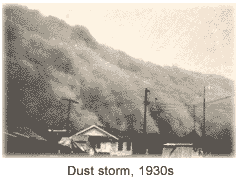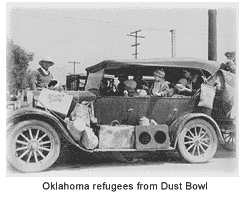The Dust Bowl was a period of severe drought and wind that occurred along the Great Plains prairies and grasslands of the U.S. and Canada during the 1930s. The ensuing dust storms damaged the agriculture and ecology of huge swaths of land, resulting in mass migration of people to the West.
And then the dispossessed were drawn west — from Kansas, Oklahoma, Texas, New Mexico; from Nevada and Arkansas, families, tribes, dusted out, tractored out. Car-loads, caravans, homeless and hungry; twenty thousand and fifty thousand and a hundred thousand and two hundred thousand. They streamed over the mountains, hungry and restless — restless as ants, scurrying to find work to do — to lift, to push, to pull, to pick, to cut — anything, any burden to bear, for food. The kids are hungry. We got no place to live. Like ants scurrying for work, for food, and most of all for land.A Promised Land— John Steinbeck. The Grapes of Wrath, 1939
What was unknown to these early pioneers was that the grass and trees of the plains essentially nourished and held the soil in place with their tough roots. When they were gone, the moisture that would have gone to the roots ran off into creeks, streams and rivers — basically carrying the land with it. The scene was set for the Dust Bowl.
In 1930, there was no better place to be a farmer than in the Southern Plains, where men and women had turned untamed prairie into one of the most prosperous regions in the whole country. The rest of the nation was struggling with the initial effects of the Great Depression, but in wheat country, farmers were reaping a record-breaking crop.
With the onset of World War I, the demand for wheat had been astonishing. Farmers were paid record prices. Thus, to the farmer, it made sense to turn every inch of the Southern Plains into profit. During the war, the land produced millions and millions of bushels of wheat and corn, which helped to feed America as well as numerous nations overseas.
The farming practices that made the plains so productive were beginning to take a toll on the land. The grasslands had been deeply plowed and planted. During the years when there was adequate rainfall, the land produced bountiful crops. However, as a drought that started in the early 1930s persisted, the farmers kept plowing and planting with increasingly dismal results.
In 1930 and early 1931, the Oklahoma and Texas panhandles were known as the most prosperous regions in the nation. For plains farmers, the decade opened with prosperity and growth. But in the summer of 1931, those farmers would face the most difficult eight years of their lives.... The rain simply stopped.
Cause and Effect
 It had taken a thousand years for Nature to build an inch of topsoil on the Southern Plains, but it took only minutes for one good blow to sweep it all away. The water level of lakes dropped by five feet or more. The wind picked up the dry soil that had nothing to hold it down. Great black clouds of dust began to blot out the sun. In some places, the dust drifted like snow, darkening the sky for days, covering even well-sealed homes with a thick layer of dust on everything. Dust storms engulfed entire towns.
It had taken a thousand years for Nature to build an inch of topsoil on the Southern Plains, but it took only minutes for one good blow to sweep it all away. The water level of lakes dropped by five feet or more. The wind picked up the dry soil that had nothing to hold it down. Great black clouds of dust began to blot out the sun. In some places, the dust drifted like snow, darkening the sky for days, covering even well-sealed homes with a thick layer of dust on everything. Dust storms engulfed entire towns.
The primary impact area of the Dust Bowl, as it came to be known, was on the Southern Plains. The Northern Plains weren`t so badly affected, but the drought, dust, and agricultural decline were felt there as well. The agricultural devastation helped to lengthen the Great Depression, whose effects were felt worldwide.
One hundred million acres of the Southern Plains were turning into a wasteland of the Dust Bowl. Large sections of five states were affected — Texas, Oklahoma, Kansas, Colorado and New Mexico.
 In 1932, the national weather bureau reported 14 dust storms. The next year, they were up to 38. The dust was so thick that people scooped up bucketsful while cleaning house. Dust blocked exterior doors; to get outside, people had to climb out their windows and shovel the dust away. Dust coated everything.
In 1932, the national weather bureau reported 14 dust storms. The next year, they were up to 38. The dust was so thick that people scooped up bucketsful while cleaning house. Dust blocked exterior doors; to get outside, people had to climb out their windows and shovel the dust away. Dust coated everything.
Nevertheless, farmers kept on plowing, hopeful that the rains would return in a matter of days, or perhaps months. In the spring of 1934, the massive drought impacted 27 states severely and affected more than 75 percent of the country. The Dust Bowl was result of the worst drought in U.S. history.
A Meager Existence
Families survived on cornbread, beans, and milk. People were beginning to give up hope, and a mass exodus — the largest migration in American history — ensued from the plains. Many families packed their belongings, piled them on their cars and moved westward, fleeing the dust and desert of the Midwest for Washington, Oregon and California. They were willing to work for any wage at all, planting and harvesting other people`s lands.
 When those families reached the borders of those western states, they were not well received — too many people already there were out of work. Many California farms were corporate owned, meaning they were larger and more modernized than what the farmers were used to. Families often lived in tar-paper shacks with no floor or plumbing. By 1940, 2.5 million people had moved out of the Dust Bowl states toward the Pacific states.
When those families reached the borders of those western states, they were not well received — too many people already there were out of work. Many California farms were corporate owned, meaning they were larger and more modernized than what the farmers were used to. Families often lived in tar-paper shacks with no floor or plumbing. By 1940, 2.5 million people had moved out of the Dust Bowl states toward the Pacific states.
In the fall of 1934, with cattle feed depleted, the government began to buy and destroy thousands of starving livestock. Of all the government programs during that time, the cattle slaughter was the most wrenching for farmers. Although it was difficult for farmers to give up their herds, the cattle slaughter helped many of them avoid bankruptcy.
In the spring of 1935, the wind blew 27 days and nights without stopping. People and animals began to die of suffocation and "dust pneumonia."
Soil Conservation
The government began to offer relief to farmers through President Franklin D. Roosevelt’s New Deal. Roosevelt believed it was the federal government`s duty to help the American people get through the bad times like the Dust Bowl. During the first three months of his presidency, a steady stream of bills were passed to relieve poverty, reduce unemployment and speed economic recovery. While these experimental programs did not end the Depression, the New Deal helped the American people immeasurably by taking care of their basic needs and giving them the dignity of work, and hope during trying times.
 Hugh Hammond Bennett, who came to be known as "the father of Soil Conservation," had been leading a campaign to reform farming practices well before Roosevelt became president. Bennett called for "...a tremendous national awakening to the need for action in bettering our agricultural practices." He urged a new approach to farming in order to avoid similar catastrophes.
Hugh Hammond Bennett, who came to be known as "the father of Soil Conservation," had been leading a campaign to reform farming practices well before Roosevelt became president. Bennett called for "...a tremendous national awakening to the need for action in bettering our agricultural practices." He urged a new approach to farming in order to avoid similar catastrophes.
In April 1935, Bennett was on his way to testify before a Congressional committee about his soil conservation campaign when he learned of a dust storm blowing into the capitol from the western plains. At last, he believed that he would have tangible evidence of the results of bad farming practices. As the dust settled over Washington and blotted out the midday sun, Bennett exclaimed, "This, gentlemen, is what I have been talking about." Congress responded by passing the Soil Conservation Act of 1935. In addition, the Roosevelt administration put its full weight and authority behind the improvement of farming techniques to prevent a recurrence of the Dust Bowl.
President Roosevelt ordered that the Civilian Conservation Corps plant a huge belt of more than 200 million trees from Canada to Abilene, Texas, to break the wind, hold water in the soil, and hold the soil itself in place. The administration also began to educate farmers on soil conservation and anti-erosion techniques, including crop rotation, strip farming, contour plowing, terracing and other beneficial farming practices.
In 1937, the federal government began an aggressive campaign to encourage Dust Bowlers to adopt planting and plowing methods that conserve the soil. The government paid the reluctant farmers a dollar an acre to practice one of the new methods. By 1938, the massive conservation effort had reduced the amount of blowing soil by 65 percent. Nevertheless, the land failed to yield a decent living.
In the fall of 1939, after nearly a decade of dirt and dust, the skies finally opened. With the rain`s return, dry fields soon yielded their golden wheat once more, and just as quickly as it had begun, the Dust Bowl was, thankfully, over.